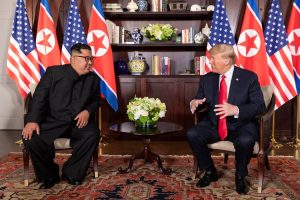Last year was a pretty good one for the Korean Peninsula. A whirlwind of diplomatic activity helped bring the region back from the brink of war, but the pace slowed toward the end of the year and 2018 ended with serious doubts about the trajectory of U.S.-North Korea negotiations.
Kim Jong Un’s customary New Year speech didn’t provide many answers about what comes next in denuclearization talks with Washington, but this does not diminish its importance for U.S. policymakers. The primary value of Kim’s address is the information it conveys about his domestic priorities for the year ahead. These priorities create incentives that U.S. negotiators should consider as they deal with their North Korean counterparts.
The most important takeaway from Kim’s address is the re-stating of a new strategic line that prioritizes economic development. Since the primary audience for the speech is the North Korean people, economic policy has loomed large in previous New Year speeches. What makes the economic section of this year’s address special is its repetition of Kim’s April 2018 announcement that the old strategic line of simultaneous development of the economy and nuclear weapons — also known as the byungjin line — is successfully completed.
Referencing the new strategic line in the New Year speech combined with the April 2018 announcement and multiple inspections of various economic projects during the summer of 2018 (and harsh criticism of their management) underscores the seriousness of Kim’s commitment to economic improvement. Furthermore, while national security and nuclear weapons were mentioned in Kim’s address, they came up very briefly. National security was mentioned in a very broad sense: “Powerful self-defense capacity is a cornerstone of the existence of a state and a guarantee for safeguarding peace.” The elevation of the new strategic line coupled with the relative downplaying of military and nuclear issues suggest that Kim’s focus on the economy will be a serious driver of his policy decisions in 2019.
This shift in North Korean domestic priorities has implications for America’s approach to negotiations on the North’s nuclear weapons program. U.S. sanctions probably did little to slow down Pyongyang’s testing and development of long-range ballistic missiles or nuclear warheads, but sanctions do make it harder for Kim to achieve his economic development goals. Getting sanctions lifted is thus a top priority, and Kim has repeatedly called for relief as part of a phased, tit-for-tat process that, in theory, will ultimately result in denuclearization.
However, refusing to lift any sanctions until North Korea makes significant steps toward denuclearization would be a serious overestimation of Washington’s leverage and would likely backfire. Kim praised inter-Korean diplomatic engagement very highly in his speech and he appears very interested in deepening cooperation with Seoul to build on the progress made last year. American recalcitrance on sanctions relief could place South Korea in the difficult position of having to choose between progress with its northern neighbor or sticking with its alliance partner. In the New Year speech, Kim also warned that his patience is not unlimited, saying “[If the United States] persists in imposing sanctions and pressure… we may be compelled to find a new way for defending the sovereignty of the country.”
The United States thus finds itself in a somewhat vexing position. Kim’s turn toward economic development makes sanctions politically potent bargaining chips that Washington is understandably reluctant to trade away, but refusing to put sanctions in play in an effort to squeeze concessions from Pyongyang is also risky and unlikely to yield the rewards the United States wants.
Given the consistency of Kim’s domestic messaging about the new strategic line over the better part of a year, the United States could make some serious progress on negotiations with North Korea if it is willing to lift some sanctions.
Limited sanctions relief would represent a kind of Goldilocks approach. For North Korea, it would show U.S. willingness to engage in reciprocal actions and be a boon for Kim’s domestic agenda. For South Korea, it would reduce a point of friction in U.S.-South Korea relations and reflect a diplomatic approach that Seoul has already used to achieve success in military confidence-building and tension reduction. Finally, partial relief would keep most U.S. sanctions in place — these could either be lifted later to entice North Korea to make more concessions in the future if it follows through on its end of the bargain or keep up some level of pressure if it reneges on its commitments.
Kim Jong Un’s New Year speech is the starting gun for diplomacy with North Korea. The speech shows that Kim is serious about the new strategic line he first put forth in April 2018 and underscores that economic development is his top priority.
The United States should incorporate these incentives into its negotiating strategy. Limited sanctions relief would send an important signal to Kim without entirely giving up U.S. leverage. If the Trump administration is willing to show some flexibility on sanctions it could make some real progress toward improving U.S.-North Korea relations, which is the only realistic way to achieve denuclearization in the long run.
Eric Gomez is a policy analyst for defense and foreign policy studies at the Cato Institute.

































